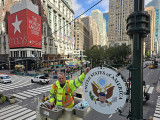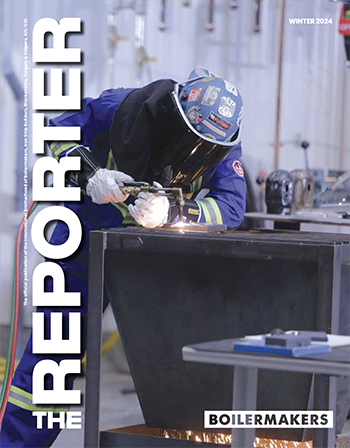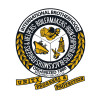I watched the towers grow from my grammar school classroom in Glendale Queens. And years later, I’m at the foot of the rubble.
From rails to ships, boilers to tanks, Boilermakers were part of the workforce that built the United States. They also maintain the country, especially the Boilermakers across New York City. One member, Blacksmith Frank Kotnik Jr., worked for the New York City Department of Transportation Maspeth Central Shops in Queens for over 26 years before his recent retirement.
Kotnik is proudly old school when it comes to education and the trades. His grandfather was a Blacksmith and his father, an ironworker. So it made sense that he attended Thomas Alva Edison Technical High School in Jamacia, and the Board of Cooperative Education for structural welding in Westbury, New York, during his formative years.
“We were taught by former tradesmen,” he said. “They weren’t just book smart, but they were out in the field. Do we need more people with a Bachelor of Liberal Arts degree, or Blacksmiths? If you have a trade and know what you’re doing you’re going to have a good job for yourself.”
And that’s exactly how Kotnik’s life has progressed. Through his job at the DOT, he designed, manufactured and installed highway sign brackets for the Brooklyn Bridge, custom traffic signal brackets, pedestrian and bike lane decorative fencing, and he performed a multitude of repairs around New York City. When a part or a bracket was missing and no one knew how to fix a problem, they’d call Kotnik, who could design and fabricate a solution, like he did for the New York City’s DOT Division of Collections.
Because the coin collection carts were in such poor condition, and they didn’t have a Blacksmith, they asked Kotnik to come up with a fix so city employees could collect coins from the parking meters.
“My claim to fame at the DOT are the 250 coin collection carts I redesigned and hand made out of scraps to collect hundreds of millions of dollars a year from the 65,000 parking meters throughout the five boroughs of NYC,” he said. “Over the years they brought in billions of dollars to the city of New York because of what I did.”
He also designed, fabricated and installed 172 brackets to hold dozens of 36-inch round aluminum disks—the Avenue of the Americas medallions.
“I even went out with the highway crew. We’d modify things to keep the city moving. It was a Band-Aid, Band-Aid, Band-Aid,” he said.
His younger coworkers called him “Uncle Frank” because he taught them old school ways of problem-solving. And while he’s proud of the work he’s done for the NYC DOT, his voice breaks when he talks about volunteering after the September 11, 2001, attacks on the World Trade Center.
“I watched the towers grow from my grammar school classroom in Glendale Queens,” Kotnik says. “And years later, I’m at the foot of the rubble.”
In the aftermath of the attack, he put in mandatory 12-hour days at work. He fabricated and installed brackets, took down certain directional signs on structures and roads and put up new ones to ensure people and traffic flowed around the rubble.
After a 12-hour shift for the city, he’d disregard how tired he felt to volunteer at Ground Zero through the night, cutting steel into 80-foot pieces to move them out of the way and doing whatever needed to be done in the moment. Often, he’d put in 22-hour days, existing only on the dream of sleep.
“The place was unbelievable,” Kotnik says. “There are not words I can use to describe what dangers were down there. It was like a moonscape. People called it ‘surreal.’ It was really something indeed.”
He admits he’s one of the many who came out of 9/11 with post-traumatic stress disorder. He’ll never forget when one of the firefighters walked over to him holding a plastic supermarket-type bag with the words “Human Remains.”
“Everything was pulverized. The horror of the body parts,” he says. “But we did what we had to do.”
He’s now facing a new issue—cancer. It hit him out of the blue around Thanksgiving 2023. Doctors attribute his cancer to his volunteer work at Ground Zero.
In the aftermath of the terrorist attacks, workers at Ground Zero saw a significant increase in cancer diagnoses among first responders and cleanup workers due to prolonged exposure to toxic dust and debris.
But Kotnik, who retired in the summer of 2024 just before his surgery for cancer, has responded well to treatment. Doctors are hopeful he and his wife can enjoy their golden years together.
Looking back over his career, he’s content with the work he’s done for his beloved New York City, both in his day job and in his work at Ground Zero. Kotnik knows he’s from a generation that’s slowly becoming extinct—the ones that use it up, wear it out, repurpose it or go without.
“There’s certain satisfaction—turning shit into gold,” Kotnik says with a laugh. “To repair something and make it new again without replacing it. When I was growing up, no one threw stuff out. You do what you got to do to repair something.”







